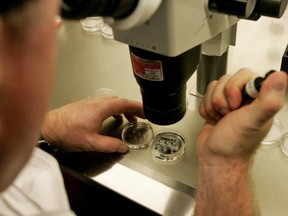Science
Scientists Transform Skin Cells into Fertilizable Eggs in Landmark Study

PARIS — A team of scientists has achieved a groundbreaking advancement in reproductive science by successfully transforming human skin cells into fertilizable eggs and fertilizing them with sperm in a laboratory setting. This milestone, announced on September 27, 2023, represents a potential shift in how infertility is understood and addressed, particularly for those unable to conceive naturally.
The research team, led by experts from the United States, cautioned that while this technology could eventually assist aspiring parents, it remains years away from practical application. Infertility, which affects approximately one in six individuals globally, could see a significant transformation if the technique, known as in-vitro gametogenesis (IVG), becomes viable.
Paula Amato, a co-author of the study based at the Oregon Health & Science University, explained the potential implications of this research. “It would allow older women or those who lack eggs for various reasons to genetically reproduce,” she stated. Moreover, it could enable same-sex couples to have children biologically related to both partners.
Recent advancements in this area of research have been notable. For instance, in July 2023, Japanese scientists announced they had created mice with two biological fathers. However, the current study, published in the journal Nature Communications, marks a significant leap by utilizing human DNA instead of animal models.
The process involved removing the nucleus from standard skin cells and transferring it into a donor egg from which the nucleus had also been extracted. This method, known as somatic cell nuclear transfer, was famously used to clone Dolly the sheep in 1996. A critical challenge remained: adjusting the chromosome count. Human skin cells contain 46 chromosomes, while eggs have only 23.
To address this, the researchers developed a technique termed “mitomeiosis,” which mimics natural cell division. They successfully created 82 developing eggs, referred to as oocytes, which were subsequently fertilized through in vitro fertilization (IVF). After six days, fewer than nine percent of these embryos developed to the stage necessary for potential transfer to a uterus. Despite this low success rate, the team highlighted that natural reproduction typically sees only about one-third of embryos reach the IVF-ready blastocyst stage.
The study’s findings also underscored the presence of various abnormalities in the embryos, leading researchers to conclude the experiment at this phase. Paula Amato estimated that it would take at least a decade for this technology to become accessible to the wider public, emphasizing that the primary challenge lies in producing genetically normal eggs with the correct complement of chromosomes.
Ying Cheong, a reproductive medicine researcher at the University of Southampton in the United Kingdom, praised the work as “exciting.” She noted, “For the first time, scientists have shown that DNA from ordinary body cells can be placed into an egg, activated, and made to halve its chromosomes, mimicking the special steps that normally create eggs and sperm.” Cheong emphasized that while this research is still in its infancy, it has the potential to reshape our understanding of infertility and miscarriage.
Other scientists pursuing egg creation are exploring alternative techniques. These methods involve reprogramming skin cells into induced pluripotent stem cells, which can differentiate into any cell type, and then converting these into eggs. Amato remarked, “It’s too early to tell which method will be more successful. Either way, we are still many years away.”
The research team adhered to established U.S. ethical guidelines regarding embryo usage during the study. As the field of reproductive science continues to evolve, these findings may pave the way for innovative solutions to infertility, offering hope to countless individuals and couples worldwide.
-

 Lifestyle1 month ago
Lifestyle1 month agoWinnipeg Celebrates Culinary Creativity During Le Burger Week 2025
-

 Health2 months ago
Health2 months agoMontreal’s Groupe Marcelle Leads Canadian Cosmetic Industry Growth
-

 Science2 months ago
Science2 months agoMicrosoft Confirms U.S. Law Overrules Canadian Data Sovereignty
-

 Education2 months ago
Education2 months agoRed River College Launches New Programs to Address Industry Needs
-

 Technology2 months ago
Technology2 months agoDragon Ball: Sparking! Zero Launching on Switch and Switch 2 This November
-

 Science2 months ago
Science2 months agoTech Innovator Amandipp Singh Transforms Hiring for Disabled
-

 Technology2 months ago
Technology2 months agoGoogle Pixel 10 Pro Fold Specs Unveiled Ahead of Launch
-

 Science2 months ago
Science2 months agoChina’s Wukong Spacesuit Sets New Standard for AI in Space
-

 Technology2 months ago
Technology2 months agoWorld of Warcraft Players Buzz Over 19-Quest Bee Challenge
-

 Science2 months ago
Science2 months agoXi Labs Innovates with New AI Operating System Set for 2025 Launch
-

 Business2 months ago
Business2 months agoDawson City Residents Rally Around Buy Canadian Movement
-

 Business2 months ago
Business2 months agoNew Estimates Reveal ChatGPT-5 Energy Use Could Soar
-

 Technology2 months ago
Technology2 months agoInnovative 140W GaN Travel Adapter Combines Power and Convenience
-

 Technology2 months ago
Technology2 months agoFuture Entertainment Launches DDoD with Gameplay Trailer Showcase
-

 Technology2 months ago
Technology2 months agoGlobal Launch of Ragnarok M: Classic Set for September 3, 2025
-

 Education2 months ago
Education2 months agoAlberta Teachers’ Strike: Potential Impacts on Students and Families
-

 Technology2 months ago
Technology2 months agoNew IDR01 Smart Ring Offers Advanced Sports Tracking for $169
-

 Technology2 months ago
Technology2 months agoArsanesia Unveils Smith’s Chronicles with Steam Page and Trailer
-

 Technology2 months ago
Technology2 months agoHumanoid Robots Compete in Hilarious Debut Games in Beijing
-

 Science2 months ago
Science2 months agoNew Precision Approach to Treating Depression Tailors Care to Patients
-

 Health2 months ago
Health2 months agoGiant Boba and Unique Treats Take Center Stage at Ottawa’s Newest Bubble Tea Shop
-

 Technology2 months ago
Technology2 months agoQuoted Tech Launches Back-to-School Discounts on PCs
-

 Business2 months ago
Business2 months agoBNA Brewing to Open New Bowling Alley in Downtown Penticton
-

 Technology2 months ago
Technology2 months agoDiscover the Relaxing Charm of Tiny Bookshop: A Cozy Gaming Escape










